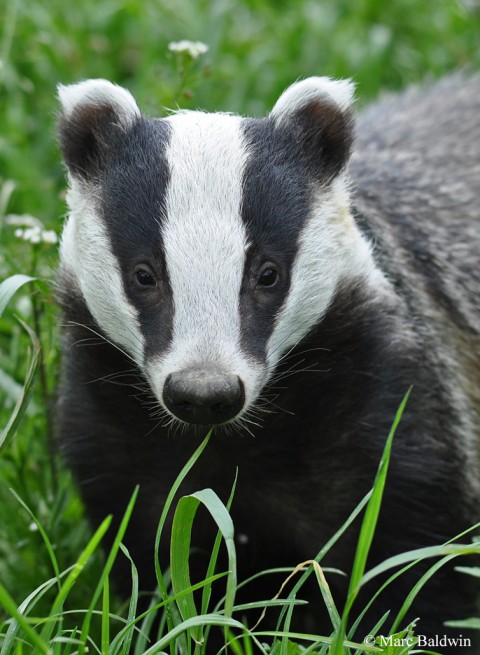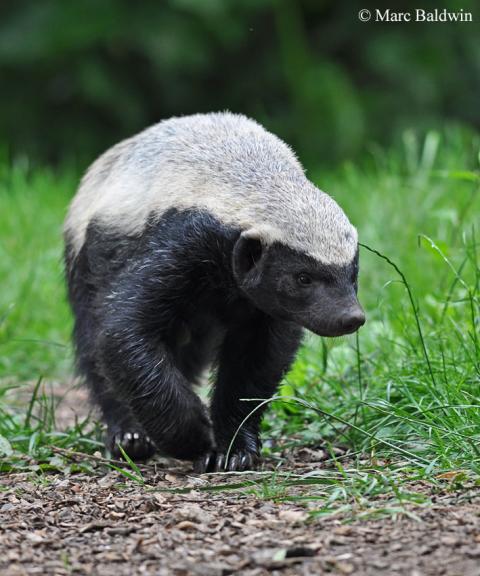Summary
It is possible that these markings hold some individual specificity, helping badgers recognise each other. More probable, however, is that the striking facial markings exhibited by badgers is a form of aposematism, where a high-contrast pattern serves as a warning to potential predators that the owner is dangerous.
The details
“In a nutshell, a badger’s markings warn other carnivores (historically mainly wolves) that, unlike other medium-sized, fluffy animals living at the woodland edge, this one bites back” wrote Oxford University’s Chris Newman in the January 2005 issue of BBC Wildlife Magazine. This situation, where possession of a conspicuous pattern (contrasting, highly coloured or both) serves to ward off potential predators is referred to as aposematism. Consequently, if one considers the mask of Meles meles to act in deterring predators from trying their luck, then it can be called an aposematic character.

With regard to colouration of mammals in general, Gloger’s Rule -- named after the German zoologist and ornithologist Constantin Gloger who proposed it in 1833 -- states that darker pigmentation should be found at the equator (where it’s warmer and/or more humid), getting progressively lighter as you move either north or south (where it’s cooler and/or drier). Additionally, Gloger’s Rule says that animals living in riparian (river) habitats possess darker pigmentation than those living in more open environments, which display lighter colours to provide camouflage and aid thermoregulation. Although most mammals seem to follow this rule, the presence of aposematic markings seems to rather fly-in-the-face of Gloger’s check-list – the patterns don’t appear to show any relation to distance from the equator, nor do they seem to change according to habitat type.
The idea that the black-and-white patterning of some mammals may act as a warning sign was first proposed by Bristol-born zoologist Reginal Pocock in a paper to the Annals and Magazine of Natural History in 1911. In his article, Pocock suggests that animals possessing these characteristics typically also have strong bites or some sprayable chemical defence.
In a recent paper to the journal Oikos, Newman, Christina Buesching (also from Oxford University) and Jerry Wolff (University of Memphis) discuss the function of facial masks in the “midguild” carnivores (i.e. those in the 10 to 20kg / 22 to 44lbs range). Newman and his colleagues looked at a number of possible hypotheses for the possession of facial markings (masks), including whether they are a cue to elicit grooming, directional cues to orient bites away from sensitive areas, or attractants to the opposite sex. The zoologists conclude that the most probable explanation for masks was aposematism, suggesting that:
“…in some species, the aggressive counter defence of midguild carnivores is sufficient in itself to select for aposematic colored face masks as warning coloration”
So, because badgers don’t spray noisome substances at -- or have alternative methods of escaping from -- anything trying to snack on them, the striking mask pattern serves to warn a potential predator that they won’t go down without a fight! The presence of the mask in newborn cubs -- which have more predators (especially foxes) than adults -- adds further weight to this theory. Moreover, badgers typically feed on subterranean prey (i.e. earthworms over the vast majority of their range), which implies that there is little (if any) danger of their mask making them more noticeable to their quarry. To this effect, Newman and his colleagues argue that facial masks do not compromise the animals’ camouflage once the face is turned away; the mask can, therefore, be revealed as necessary. Indeed, the late, great badger guru Ernest Neal once described how a sow flattened herself to the ground by the entrance of her sett and partly covered her face with her fore paws upon hearing a dog barking nearby; Neal wrote that: “The camouflage was perfect”.
Another hypothesis suggests that badgers might be able to use the mask pattern to tell each other apart; this is the “Recognition Hypothesis”. In his book, Badgers, former Mammal Society president the late Michael Clark described how he was able to identify eight adults (5 sows, 3 boars) from his local sett in Hertfordshire based on facial differences; at least four (2 boars, 2 sows) were readily identifiable based on their mask. Considering that badgers apparently have rather poor eyesight -- based largely on observations of badgers in the field -- the monochromatic mask pattern is probably very conspicuous (even under conditions of low light) and it seems reasonable that if a badger watcher is capable of using the mask to identify individuals, so are other badgers. Indeed, in their book -- also entitled Badgers -- Central Science Laboratory biologist Chris Cheeseman and Ernest Neal described how experiments with mirrors and stuffed badgers have shown that other badgers recognise the mask pattern at once. Similarly, Neal and Cheeseman reported the results of an experiment by David Humphries, from which he discovered that when he “held a badger’s mask in front of his face, the badgers appeared to accept him as one of them as he crawled about on the ground nearby, but down wind.”

Not everyone agrees with the recognition hypothesis, however, at least not as a ‘driver’ for mask evolution (and aposematism in general), which -- according to Newman and his co-workers -- is a polyphyletic characteristic; they report that it has evolved independently in four Carnivore families and several times within each family. In their paper, they argue that the majority of masked midguild carnivores are asocial (i.e. solitary) and communicate primarily with scent – indeed, badgers are typically solitary (except where resources permit social cohesion) and their reliance on scent to mark their territory and conspecifics is well documented. Additionally, a study on badgers in Plymouth’s Radford Woods Oil Fuel Depot by marine biologist David Dixon, found that only one member of the clan could be readily identifiable by facial characteristics (at least using CCTV footage) and this was a missing ear, rather than a specific mask pattern. Instead, Dixon found that he could positively identify 95% of the badgers on the basis of their tail morphology, which remained largely unchanged during his two-year study.
Ultimately, I think it reasonable that the striking mask sported by Meles meles is, in the first instance, aposematic: it lets predators know that this fantastic fur-ball is not to be messed with. It is not, however, unreasonable to consider that masks also have an intraspecific recognition function that works -- presumably in conjunction -- with olfactory cues (i.e. badgers recognise each other by face mask as well as by smell). Indeed, it should be remembered that badgers are almost certainly not visually motivated animals, instead it is scent that plays the pivotal role in helping them identify other badgers and the world in which they live.